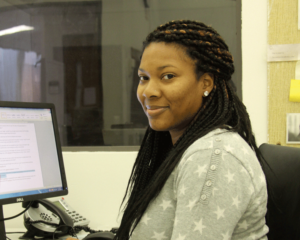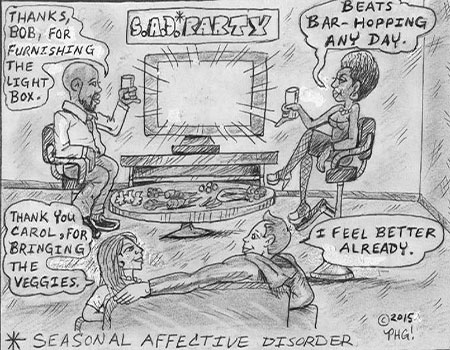
The Scene staff
The combination of short, gloomy days and frigid temperatures can be a downer for anyone.
Last winter was really bad. It was one of the coldest, most brutal winters I could remember, with arctic winds chapping my cheeks and turning my hair into brittle strands.
I dreaded getting out of bed, knowing I would have to face a cold gray day or — even worse — a cold gray day in the snow. I was irritable and groggy.
Standing at bus stops in the dark was especially miserable. I was constantly trying to pump myself up with caffeine, but it didn’t work.
Some people call this the “winter blues,” but doctors have come up with a diagnosis called “seasonal affective disorder.”
It typically affects people during colder, shorter days of the year. As seasons change, our internal clocks cause us to be out of step with our daily rhythms. Chemicals in our brains can become unbalanced.
For instance, the sleep hormone melatonin increases when it is dark. The earlier it gets dark outside, the more likely we are to become sleepy.
This all makes sense to me now. I thought I was beginning to hate winter, but I was facing a biological problem. I was surprised to find out that seasonal affective disorder existed, but the acronym — SAD — is perfect for the misery I have felt in the winter.

A conversation I had with my best friend about my condition was confusing, but hilarious.
ME: “I know have been really tired and crabby lately. It’s because I have SAD.”
BFF: “Oh no. (She hugs me.) Let’s go to the mall and buy shoes. You’ll feel better.”
ME: “I don’t think you understand. I have SAD.”
BFF: “Yes, you’re sad. You want to get FroYo while we are out, too?”
ME: (Sigh.)
I learned about SAD too late to do much about it last winter. This winter, I am more prepared to tackle any symptoms that come my way.
I did a little research and found that most treatments are natural, habit-based or diet-based.
One product proven to help many people is a light box, which emits light and mimics the sun. It activates hormones and chemicals in your body that make you happy and balance you out.
Doctors say you should sit in front of the light box for at least 30 minutes a day to get the full effect.
I’m a caffeine addict. Last winter, when I had trouble staying awake, I would drink anything I thought would give me energy. Red Bull, 5-Hour Energy and Mountain Dew were just a few of my go-to drinks.
I was a regular customer at a coffee shop attached to a store where I work. Peppermint lattes were my favorite.
Seems illogical, but as it turns out, caffeine is one of the worst things for someone dealing with SAD. Caffeine spikes your blood sugar, making you feel even sleepier than before.
I will be drinking a peppermint latte or two this winter — it makes me feel seasonal — but I won’t be using them as my fuel.
On cold winter days, when I’m off work and don’t have any class projects, the only thing I want to do is hang out on the couch with a bowl of my grandma’s macaroni and cheese and a “Grey’s Anatomy” marathon.
There’s nothing wrong with vegging out, but it’s important to actually eat vegetables in the winter.
Balanced meals should include healthy, colorful vegetables. Complex carbohydrates increase serotonin, a mood-boosting hormone, and give you energy.
Sometimes, eating healthy can be inconvenient, but I have found quick easy recipes that are still nutritious.
Winter can be a super busy time for me. I’m always either at work, in class or being social.
There are times when I just want to lie under the covers, hiding from the frigid cold. But I have to make an effort to stay connected with friends and family. That means real-life, face-to-face communication, not today’s digital chats.
Hanging out with family and friends also releases chemicals in our bodies that make us happy.
I’m an introvert, so being around too many people for too long can cause irritation and anxiety. I set priorities. I don’t go to every party I’m invited to.
If you’re feeling down, it’s best to stay off social media. Sites such as Facebook only show what people choose to post. Seeing photos of others smiling and having a good time can give you a false impression that everyone is living a better life than you.
I would also suggest making time to do things you enjoy. I love crafts. I don’t always finish projects I start, but when I am making bracelets or decoupaging cigar boxes, I’m at peace.
Most importantly, if you’ve done everything you can think of and you still feel irritable or sad or have thoughts or hurting yourself or others, you may have something more severe than seasonal affective disorder.
Talk to a counselor or doctor. Everyone deserves to have a happy, healthy winter.
